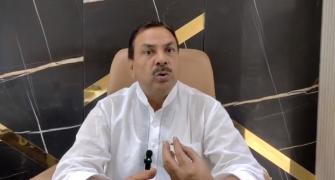Even the best of government policies rarely satisfy the intended beneficiaries, especially the vocal corporate sector. So, it is perhaps surprising that the year 2006 saw a scheme over which all business houses -- big and small alike -- were falling head over heels.
In fact, no policy, programme or legislation, including the Special Economic Zone (SEZ) policy of 2000, in recent memory has witnessed such a euphoria among India Inc as the Special Economic Zones Act. This is clearly evident as in less than 10 months more than 600 proposals by private companies envisaging an estimated investment of about Rs 1,00,000 crore (Rs 1,000 billion) in the next 2-3 years have either been approved or are awaiting government clearance.
The Act, passed in 2005 but operationalised in February this year, not just caught the fancy of the corporate sector -- it also led to one of the most eagerly-watched duels over any economic issue within the government in 2006.
While Finance Minister P Chidambaram and his team in North Block repeatedly voiced concern over the revenue loss to exchequer on account of tax sops to SEZs, Commerce Minister Kamal Nath and Commerce Secretary G K Pillai have been the most ardent supporters of the policy.
The tussle over revenue implications intensified when the Reserve Bank and IMF chief economist Raghuram Rajan echoed Chidambaram's views, while companies and industry chambers strongly supported Nath and Pillai.
The other contentious issue in the scheme related to land acquisition, with farmers, NGOs, various political parties and even Congress President Sonia Gandhi expressing concern over using farm land for industrial purposes.
Just when it looked like the arguments would continue forever, Prime Minister Manmohan Singh laid to rest all doubts about the need for SEZ, although he also accepted the concerns related to acquisition of farm land for non-farm purposes.
"SEZs have come to be accepted as a part of the new policy paradigm we have evolved. I do believe SEZs have a role to accelerate the growth and to generate more employment," he told industry leaders at a conference in October.
"Concerns have been raised with regard to acquisition of agriculture land. We will take these concerns on board. . . (but) SEZs have come to stay," Singh declared.
Specifically, the concerns related to only a few projects such as Reliance Industries' Haryana SEZ and two SEZs in Maharashtra and Reliance Energy's Dadri SEZ in Uttar Pradesh.
Land related issues were only one of the controversies that the scheme has generated. The biggest difference within the government was over revenue gains or losses.
Chidambaram said the government will lose up to Rs 1,00,000 crore in next few years on account of tax sops to SEZs, while the Commerce Ministry felt these zones could make the exchequer richer by Rs 45,000 crore (Rs 450 billion) annually.
Commerce secretary G K Pillai, who was earlier additional secretary and then special secretary in the commerce ministry, took the finance ministry's argument in the reverse direction. Pillai, who chairs the Board of Approvals for SEZs, said if there is a revenue loss of Rs 1,00,000 crore, then going by simple calculations all SEZ developers and units will earn a profit of Rs 3,00,000 crore (Rs 3,000 billion) and revenue of Rs 15,00,000 crore (Rs 15,000 billion).
Further, while companies get tax exemptions, employees will have to pay all taxes. This will result in a net revenue to the government of Rs 45,000 crore, he argued.
Tax sops were not the only point of difference. The finance ministry favoured a limit on the number of SEZs. Moreover, as SEZs would be foreign territory for customs purpose, the finance ministry wanted administrative control. But like a shrewd
politician, Nath managed to have an upper hand on Chidambaram.
Besides, Communications and IT Ministry under Dayanidhi Maran wanted supervision over SEZs for IT and ITeS sectors.
Ministries apart, the SEZ scheme has not found much favour with RBI and insurance regulator IRDA. The Reserve Bank earlier this year told banks to treat exposure to SEZs as lending to real estate and not infrastructure projects. RBI also said SEZs could lead to uneven economic growth.
Insurance Regulatory Development Authority refused to give any special treatment to SEZs, with Chairman C S Rao making it clear there cannot be 100 per cent foreign direct investment for insurance companies within these zones.
But all this opposition failed to deter Indian or global companies. While IT giants such as TCS, Infosys, Wipro, Satyam and smaller firms took a lead, other corporate giants such as RIL, Essar, Tatas, Bajaj Auto, Bharat Forge and international players like Nokia, Flextronics, Posco and Indonesia's Salim group are setting up SEZs for auto, pharma, energy, textiles, tourism, steel, aluminium and multi-product zones as well.
Clearly, even staunch advocates of SEZ policy -- Pillai and Nath -- would not have dreamt of the tremendous response from Indian and international companies, although a few companies such as Hewlett-Packard have backed out since then.
While the concerns were not unfounded, such conflicting positions send a wrong signal to investors. The policy might be fine-tuned, but skeptics should wait for some time. As Pillai says, the SEZ scheme requires a year or two to start showing definite results. Indeed, only time will tell!







